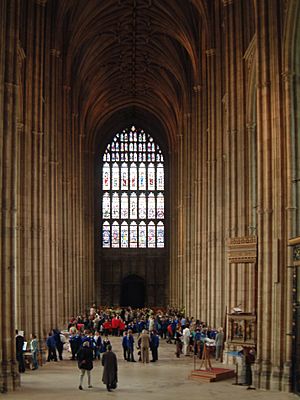Thomas Chillenden facts for kids
Thomas Chillenden was an important leader, known as the Prior, of Canterbury Cathedral from 1391 to 1410. During his time, from 1391 to 1400, the main part of the Cathedral church, called the nave, was rebuilt. It was designed in a special style of building called Perpendicular Gothic, which was popular in England. Chillenden passed away on August 15, 1411.
Contents
Chillenden's Life Story
His Early Years and Studies
Thomas Chillenden's family likely came from a village in Kent, England, also named Chillenden. We don't know much about his parents. He became a monk at Christ Church Priory, which is part of Canterbury Cathedral.
He went to Canterbury College, Oxford, to study canon law. This is a special type of law used by the church. He studied there from 1365 to 1378. After Oxford, he traveled to Rome to continue his studies in canon law at the papal curia. This was like the Pope's main office.
By 1383, he had earned a high degree, becoming a Doctor of Canon Law. While in Rome, he wrote an index for a book of church laws. He also wrote a commentary on legal rules and gave lectures. In 1383, he helped the University of Oxford in a disagreement with another religious house, St Frideswide's Priory.
Leading the Priory: Thomas Chillenden as Prior
Before becoming the Prior, Chillenden worked as one of the Priory's treasurers. This means he managed their money. When he became Prior, he continued to keep a close eye on the monastery's finances. He made sure all the money coming in, like donations or income from their lands, went through his office.
He then decided how much money each department or "obedientary" (like the cellarer who managed food, or the sacrist who managed the church's sacred items) would receive. This helped him control spending.
The monastery owned many farms and lands, called manors. After the Black Death (a terrible plague), it was hard to decide if the monastery should manage these lands directly or rent them out. Chillenden decided to stop managing them directly. He changed the system so that instead of paying rent in money, people paid with a set amount of farm animals or grain. This was a smart way to deal with changing money values.
During Chillenden's time as Prior, the monastery's library grew a lot. They added 24 books on church law and 11 books on civil law. One of these books was thought to be written by Chillenden, but it was actually written by another monk named John.
Rebuilding and New Construction
Because Chillenden was so good at managing money, he was able to restart a huge building project. The rebuilding of the nave (the main part of the church) had stopped in 1381 after a leader named Simon Sudbury was killed. Within a year of becoming Prior, Chillenden got the project going again.
He also started a big plan to invest in new buildings and improvements. This happened in cities like Southwark in London, where the Priory bought and built new houses and shops. In Canterbury, they built new buildings and a huge new inn called The Chequers. They also bought another inn called The Crown.
On the Priory's rural lands, new barns, stables, and mills were built. Many of these had roof tiles, which was quite rare back then. Inside the Priory itself, the chapter house (where monks met) was repaired. They also bought a beautiful new silver-gilt altar table. Chillenden greatly improved the Prior's own chapel and home, along with other buildings. A hundred years after he died, a historian named John Leland called him "the greatest builder" among all the Priors.
Chillenden's Role in Politics
Thomas Chillenden was the last Prior of Canterbury to attend the English Parliament. He was called by King Richard II to a meeting in Oxford in 1399. His job was to give advice to the king about the Western Schism. This was a time when there were two or even three Popes at once, causing a big split in the church.
King Richard also appointed Chillenden to investigate goods belonging to merchants from Gueldres (a region in Europe) who were living in England. In 1409, Chillenden represented both Christ Church Priory and the English King at the Council of Pisa. This was another important meeting to try and solve the church's split. Five years earlier, in 1405, he had been chosen to be the bishop of Rochester, but he chose not to accept that role.
Images for kids



